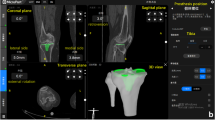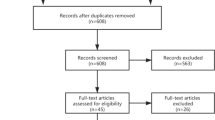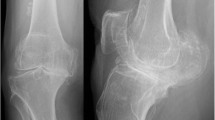Abstract
Purpose
Mobile-bearing knee replacements were introduced as an alternative to their fixed-bearing counterparts. Movement of the polyethylene insert relative to the tibial tray has been shown to decrease contact stresses, wear and polyethylene-induced osteolysis. The aim of this study is to compare outcomes between mobile and fixed-bearing surfaces of the Rotaglide+ total knee prosthesis.
Methods
A prospective, partially randomised twin cohort study of 149 Rotaglide+ total knee arthroplasties performed in one unit between September 2000 and January 2005, was carried out. The patients were allocated to a mobile or fixed bearing. The patients were assessed using a pain visual analogue score (VAS), the American Knee Surgeons Score (AKSS) the range of movement, the Oxford Knee Score (OKS) and walking time. Seventy-five patients had mobile-bearing surfaces, and 74 had fixed bearings.
Results
At 5-year follow–up, there was no significant difference between the fixed- and mobile-bearing implants with respect to range of movement [104.7(SD 17.0) vs. 103.6(SD 15.7) degrees]; AKSS [146.6(SD 23.9) vs. 144.1(SD 32.4)]; VAS [3.3(SD 1.2) vs. 3.4(SD 1.3)]; OKS [30.8(SD 9.7) vs. 29.6(SD 10.9)], respectively.
Conclusion
This study is the first of its kind to outline the medium-term (≥5 years) outcomes in Rotaglide+ total knee replacements. Its findings reinforce previous research which has shown no discernible difference in clinical outcomes between the 2 groups.
Level of evidence
II.







Similar content being viewed by others
References
Aglietti P, Baldini A, Buzzi R, Lup D, De Luca L (2005) Comparison of mobile-bearing and fixed-bearing total knee arthroplasty: a prospective randomized study. J Arthroplast 20:145–153
Ball ST, Sanchez HB, Mahoney OM, Schmalzried TP (2011) Fixed versus rotating platform total knee arthroplasty: a prospective, randomized, single-blind study. J Arthroplast 26:531–536
Buechel FF, Pappas MJ (1986) The New Jersey low-contact-stress knee replacement system: biomechanical rationale and review of the first 123 cemented cases. Arch Orthop Trauma Surg 105:197–204
Dixon MC, Brown RR, Parsch D, Scott RD (2005) Modular fixed-bearing total knee arthroplasty with retention of the posterior cruciate ligament. A study of patients followed for a minimum of fifteen years. J Bone Jt Surg Am 87:598–603
Gill GS, Joshi AB (2001) Long-term results of kinematic condylar knee replacement. An analysis of 404 knees. J Bone Jt Surg Br 83:355–358
Hansson U, Toksvig-Larsen S, Jorn LP, Ryd L (2005) Mobile vs. fixed meniscal bearing in total knee replacement: a randomised radiostereometric study. Knee 12:414–418
Ho FY, Ma HM, Liau JJ, Yeh CR, Huang CH (2007) Mobile-bearing knees reduce rotational asymmetric wear. Clin Orthop Relat Res 462:143–149
KAT Trial Group, Johnston L, MacLennan G, McCormack K, Ramsay C, Walker A (2009) The knee arthroplasty trial (KAT) design features, baseline characteristics, and two-year functional outcomes after alternative approaches to knee replacement. J Bone Jt Surg Am 91:134–141
Kim YH, Kim DY, Kim JS (2007) Simultaneous mobile- and fixed-bearing total knee replacement in the same patients. A prospective comparison of mid-term outcomes using a similar design of prosthesis. J Bone Jt Surg Br 89:904–910
Kim YH, Kim JS (2009) Prevalence of osteolysis after simultaneous bilateral fixed- and mobile-bearing total knee arthroplasties in young patients. J Arthroplast 24:932–940
Kim YH, Kook HK, Kim JS (2001) Comparison of fixed-bearing and mobile-bearing total knee arthroplasties. Clin Orthop Relat Res 11:101–115
Kim YH, Yoon SH, Kim JS (2007) The long-term results of simultaneous fixed-bearing and mobile-bearing total knee replacements performed in the same patient. J Bone Jt Surg Br 89:1317–1323
Lu YC, Huang CH, Chang TK, Ho FY, Cheng CK, Huang CH (2010) Wear-pattern analysis in retrieved tibial inserts of mobile-bearing and fixed-bearing total knee prostheses. J Bone Jt Surg Br 92:500–507
Matsuda S, Mizu-uchi H, Fukagawa S, Miura H, Okazaki K, Matsuda H, Iwamoto Y (2010) Mobile-bearing prosthesis did not improve mid-term clinical results of total knee arthroplasty. Knee Surg Sports Traumatol Arthrosc 18:1311–1316
Matsuda S, White SE, Williams VG II, McCarthy DS, Whiteside LA (1998) Contact stress analysis in meniscal bearing total knee arthroplasty. J Arthroplast 13:699–706
Price AJ, Rees JL, Beard D, Juszczak E, Carter S, White S, de Steiger R, Dodd CA, Gibbons M, McLardy-Smith P, Goodfellow JW, Murray DW (2003) A mobile-bearing total knee prosthesis compared with a fixed-bearing prosthesis. A multicentre single-blind randomised controlled trial. J Bone Jt Surg Br 85:62–67
Rao AR, Engh GA, Collier MB, Lounici S (2002) Tibial interface wear in retrieved total knee components and correlations with modular insert motion. J Bone Jt Surg Am 84-A:1849–1855
Rodricks DJ, Patil S, Pulido P, Colwell CW Jr (2007) Press-fit condylar design total knee arthroplasty. Fourteen to seventeen-year follow-up. J Bone Jt Surg Am 89:89–95
Sawaguchi N, Majima T, Ishigaki T, Mori N, Terashima T, Minami A (2010) Mobile-bearing total knee arthroplasty improves patellar tracking and patellofemoral contact stress in vivo measurements in the same patients. J Arthroplast 25:920–925
Skwara A, Tibesku CO, Ostermeier S, Stukenborg-Colsman C, Fuchs-Winkelmann S (2009) Differences in patellofemoral contact stresses between mobile-bearing and fixed-bearing total knee arthroplasties: a dynamic in vitro measurement. Arch Orthop Trauma Surg 129:901–907
Smith H, Jan M, Mahomed NN, Davey JR, Gandhi R (2011) Meta-analysis and systematic review of clinical outcomes comparing mobile bearing and fixed bearing total knee arthroplasty. J Arthroplast 26:1205–1213
Stukenborg-Colsman C, Ostermeier S, Hurschler C, Wirth CJ (2002) Tibiofemoral contact stress after total knee arthroplasty: comparison of fixed and mobile-bearing inlay designs. Acta Orthop Scand 73:638–646
Wylde V, Learmonth I, Potter A, Bettinson K, Lingard E (2008) Patient-reported outcomes after fixed- versus mobile-bearing total knee replacement: a multi-centre randomised controlled trial using the kinemax total knee replacement. J Bone Jt Surg Br 90:1172–1179
Conflict of interest
None declared.
Author information
Authors and Affiliations
Corresponding author
Rights and permissions
About this article
Cite this article
McGonagle, L., Bethell, L., Byrne, N. et al. The Rotaglide+ total knee replacement: a comparison of mobile versus fixed bearings. Knee Surg Sports Traumatol Arthrosc 22, 1626–1631 (2014). https://doi.org/10.1007/s00167-012-2351-5
Received:
Accepted:
Published:
Issue Date:
DOI: https://doi.org/10.1007/s00167-012-2351-5




